
The Maquis were rural guerrilla bands of French and Belgian Resistance fighters, called maquisards, during the German military administration in occupied France during World War II. Initially, they were composed of young, mostly working-class, men who had escaped into the mountains and woods to avoid conscription into Vichy France's Service du travail obligatoire which provided forced labor for Germany. To avoid capture and deportation to Germany, they became increasingly organized into active resistance groups.

The French Resistance was a collection of groups that fought the Nazi occupation of France and the collaborationist Vichy régime in France during the Second World War. Resistance cells were small groups of armed men and women who conducted guerrilla warfare and published underground newspapers. They also provided first-hand intelligence information, and escape networks that helped Allied soldiers and airmen trapped behind Axis enemy lines. The Resistance's men and women came from many different parts of French society, including émigrés, academics, students, aristocrats, conservative Roman Catholics, Protestants, Jews, Muslims, liberals, anarchists, communists, and some fascists. The proportion of French people who participated in organized resistance has been estimated at from one to three percent of the total population.
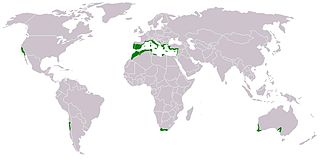
Maquis or macchia is a shrubland biome in the Mediterranean region, typically consisting of densely growing evergreen shrubs.

Shrubland, scrubland, scrub, brush, or bush is a plant community characterized by vegetation dominated by shrubs, often also including grasses, herbs, and geophytes. Shrubland may either occur naturally or be the result of human activity. It may be the mature vegetation type in a particular region and remain stable over time, or a transitional community that occurs temporarily as the result of a disturbance, such as fire. A stable state may be maintained by regular natural disturbance such as fire or browsing. Shrubland may be unsuitable for human habitation because of the danger of fire. The term was coined in 1903.

Matorral is a Spanish word, along with tomillares, for shrubland, thicket or bushes. It is used in naming and describing a Mediterranean climate ecosystem in Southern Europe.

Garrigue or garigue, also known as phrygana, is a type of low scrubland ecoregion and plant community in the Mediterranean forests, woodlands, and scrub biome.
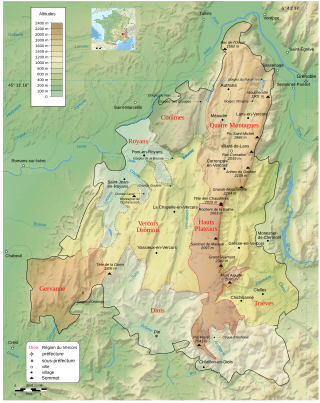
The Battle of Vercors in July and August 1944 was between a rural group of the French Forces of the Interior (FFI) [maquis] and the armed forces of Nazi Germany which had occupied France since 1940 in the Second World War. The maquis used the prominent scenic plateau known as the Massif du Vercors as a refuge. The maquis carried out sabotage and partisan operations against the Germans. After the Normandy Invasion of 6 June 1944, the leadership of a force of about 4,000 maquis declared the Free Republic of Vercors and attempted to create a conventional army to oppose the German occupation.

Gyromitra infula, commonly known as the hooded false morel or the elfin saddle, is a fungus in the family Helvellaceae. The dark reddish-brown caps of the fruit bodies develop a characteristic saddle-shape in maturity, and the ends of both saddle lobes are drawn out to sharp tips that project above the level of the fruit body. The stipe is white or flushed pale brown, smooth on the outside, but hollow with some chambers inside. It is found in the Northern Hemisphere, usually in the late summer and autumn, growing on rotting wood or on hard packed ground. G. infula is considered inedible as it contains the toxic compound gyromitrin which, when metabolized by the body, is converted into monomethylhydrazine, a component of some rocket fuels. The toxin may be removed by thorough cooking. Gyromitra fungi are included in the informal category "false morels".

Helvella is a genus of ascomycete fungus of the family Helvellaceae. The mushrooms, commonly known as elfin saddles, are identified by their irregularly shaped caps, fluted stems, and fuzzy undersurfaces. They are found in North America and in Europe. Well known species include the whitish H. crispa and the grey H. lacunosa. They have been reported to cause gastrointestinal symptoms when eaten raw.
The Maquis de Saint-Marcel was a force of French resistance fighters, 3000 men with 200 Free French SAS, during World War II operating in Brittany, Morbihan. It was created just before the Normandy landings with the objectives of preventing German army reinforcements from reaching the coast, thus facilitating the task of the allied landing forces.
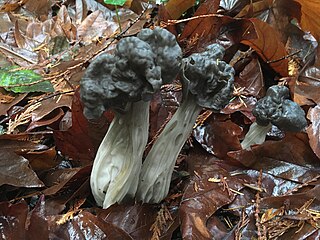
Helvella lacunosa, known as the slate grey saddle or fluted black elfin saddle in North America, simply as the elfin saddle in Britain, is an ascomycete fungus of the family Helvellaceae. It is one of the most common species in the genus Helvella. The mushroom is readily identified by its irregularly shaped grey cap, fluted stem, and fuzzy undersurfaces. It is usually found in Eastern North America and in Europe, near deciduous and coniferous trees in summer and autumn.
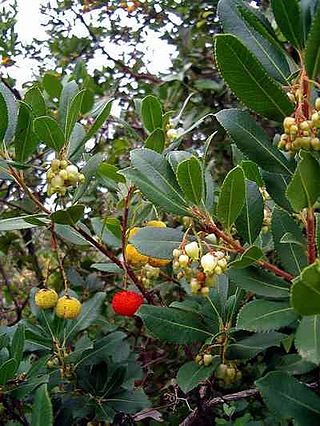
The flora of Italy is all the plant life present in the territory of the Italian Republic. The flora of Italy was traditionally estimated to comprise about 5,500 vascular plant species. However, as of 2019, 7,672 species are recorded in the second edition of the flora of Italy and in its digital archives Digital flora of Italy. In particular, 7,031 are autochthonous and 641 are non native species widely naturalized since more than three decades. Additionally, further 468 exotic species have been recorded as adventitious or naturalized in more recent times.

Helvella acetabulum is a species of fungus in the family Helvellaceae, order Pezizales. This relatively large cup-shaped fungus is characterized by a tan fruit body with prominent branching ribs resembling a cabbage leaf; for this reason it is commonly known as the cabbage leaf Helvella. Other colloquial names include the vinegar cup and the brown ribbed elfin cup. The fruit bodies reaches dimensions of 8 cm (3.1 in) by 4 cm (1.6 in) tall. It is found in Asia, Europe, and North America, where it grows in sandy soils, under both coniferous and deciduous trees.
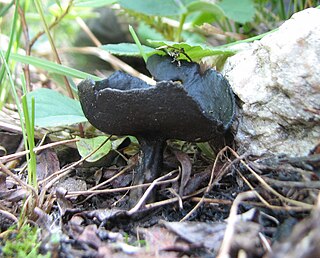
Helvella corium is a species of fungus in the family Helvellaceae of the order Pezizales. This inedible cup-shaped fungus is black, and grows on the ground often near willows in deciduous or mixed forests.
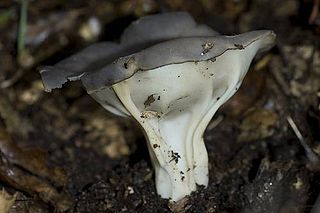
Helvella costifera is a species of fungus in the family Helvellaceae, Pezizales order. Its ascocarp has conspicuous ribs on its undersurface.

Wynnella is a genus of ascomycete fungi of the family Helvellaceae. It contains two species, the type, W. auricula, and W. silvicola. The genus was circumscribed by French mycologist Jean Louis Émile Boudier in 1885. Wynnella is a sister genus to Helvella.
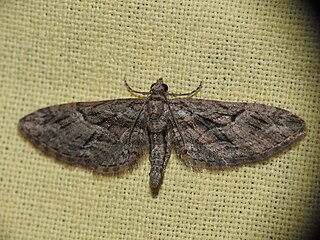
Eupithecia oxycedrata is a species of moth in the family Geometridae. It is found in Spain, southern Portugal, the Balearic Islands, southern France, Corsica, Sardinia, Sicily, Malta, Italy, Slovenia, Croatia, Bosnia and Herzegovina, Montenegro, North Macedonia, Bulgaria, Greece, Crete, western Romania and the Crimea. It is also found in North Africa, from Morocco to Tunisia, and in Turkey. The habitat consists of dry maquis, especially where junipers grow.

The Gulf of Porto is a gulf of the Mediterranean Sea located on the western façade of the island of Corsica, France, well known for its dramatic coloration and rugged cliffs. The gulf is located within the department of Corse-du-Sud. The gulf and surrounding coast is part of the Regional Natural Park of Corsica. In 1983 the gulf was designated as a UNESCO World Heritage Site, encompassing the Calanques de Piana, Gulf of Girolata, and Scandola Nature Reserve, due to its outstanding scenery, rich avian and marine life, and maquis shrubland.
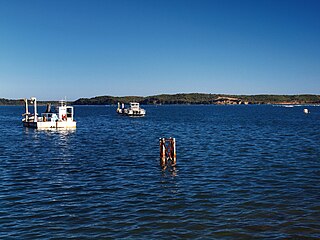
The Étang de Diane is a coastal lagoon beside the Tyrrhenian Sea on the east coast of Haute-Corse department on the French island of Corsica. The lagoon served as a port for the Ancient Greeks, and then for the Romans. Today it is privately owned and mainly used for shellfish farming and fishing.
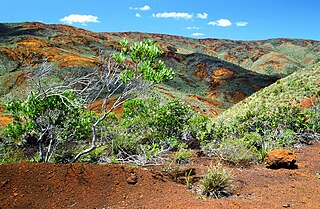
Mining maquis is a type of shrubland biome. It forms on ultramafic rock as a result of forest cover retreat due to repeated wildfires. It is common on New Caledonia.


















